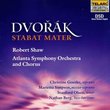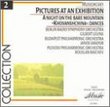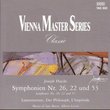| All Artists: Perotin, Notre Dame School Anonymous, Leonin, Gregorian Chant, 11th century French Polyphony Anonymous, TONUS PEREGRINUS, Rebecca Hickey, Joanna Forbes, Richard Eteson, Alexander Hickey Title: Leonin, Perotin: Sacred Music from Notre-Dame Cathedral Members Wishing: 2 Total Copies: 0 Label: Naxos Original Release Date: 1/1/2005 Re-Release Date: 7/19/2005 Genres: Special Interest, Classical Styles: Opera & Classical Vocal, Historical Periods, Early Music Number of Discs: 1 SwapaCD Credits: 1 UPC: 747313234028 |
Search - Perotin, Notre Dame School Anonymous, Leonin :: Leonin, Perotin: Sacred Music from Notre-Dame Cathedral
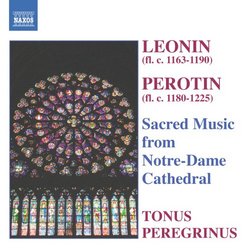 | Perotin, Notre Dame School Anonymous, Leonin Leonin, Perotin: Sacred Music from Notre-Dame Cathedral Genres: Special Interest, Classical
|
Larger Image |
CD DetailsSimilarly Requested CDs
|
CD ReviewsA Resounding Success Timothy R. O'Hanlon | Hawaii | 12/27/2005 (5 out of 5 stars) "If one read the album notes but failed to read the fine print on the rear of the jacket, one would likely assume that this recording was made in Notre Dame Cathedral, which it was not. It was recorded at Chancelade Abbey, Dordogne, France. (http://chapaq.free.fr/Congregations/Chancelade.htm) The notes mention the fact that both Leonin and Perotin worked at Notre Dame and were both responsible for the Organum. Organum is Polyphony used in liturgical music from the late 9th century to c. 1250. I bring this up because few people, even musicologists, understand the vital roles that acoustics and harmonics(overtones)played in the composition of sacred music until about the Seventeenth Century. The musicologist, Thurston Dart, summarizes the influence that reverberation has on composers: "But even a superficial study shows that early composers were very aware of the effect on their music of the surroundings in which it was to be performed, and that they deliberately shaped their music accordingly. Musical acoustics can be roughly divided into resonant, room and outdoor. Plainsong is resonant music; so is the harmonic style of Leonin and Perotin .. Perotin's music, in fact, is perfectly adapted to the acoustics of the highly resonant cathedral (Notre Dame Paris) for which it was written...." (Thurston Dart, musicologist, "The interpretation of Music",Hutchinson, London pp56-57 (1954). I think, like most 'moderns', Mr. Dart has got it backwards -- these composers were mostly aware of the effect of the surroundings upon their music. Composers like Leonin and Perotin and others, notably Allegri (composer of the famous "Miserere"), were more interested on the effect that the music, augmented by the acoustics, had on the congregation, in terms of literally uplifting their spirits and assisting them in participating directly in what was called the "Communion of Saints". E. Power Biggs said: "An organist will take al the reverberation time he is given, and then ask for a bit more.... Many of Bach's organ works are designed .... to explore reverberation. Consider the pause that follows the ornamented proclamation that opens the famous Toccata in D minor. Obviously this is for the enjoyment of the notes as they remain suspended in the air". Church music sounds wrong when performed in a small non-reverberant space with a lot of acoustic absorbent such as curtains and carpets." (http://www.acoustics.salford.ac.uk/acoustics_world/concert_hall_acoustics/acoustics_music.html) E. Power Biggs and the pundits at Salford University, assume that Bach and his predecessors valued acoustics and resonance primarily from the standpoint of aesthetics. In other words, they chose reverberant halls because their music sounded better when performed in them. I believe that they too are missing the point. Acoustic Archeologists, like John Reid and Paul Devereux are beginning to discover that ancient holy places, such as Stonehenge and also the Gothic Cathedrals, like Notre Dame de Paris, were actually tuned to resonate certain specific pitches or sound frequencies. They are or contain what are called "resonant chambers". A resonant chamber essentially reflects and amplifies or "empowers" certain specific frequencies, particularly when they are sung by a chorus (or congregation) of "pure voices" in unison. These frequencies and the harmonies reproduced by the reverberations elicited certain specific emotional responses, such as awe and reverence, from the assembly. I'm sure that Leonin and Perotin were well aware of the marvelous acoustics of Notre Dame and structured their music to take full advantage of it. After the invention of the printing press, increasingly more emphasis was placed on the written and spoken word. Music was no longer spontaneously created or improvised and less and more reverberant acoustics only served to muddle the words of the preacher or celebrant. I'm guessing that the reason why the producer, Jeremy Summerly, chose not to record this music in its original home is because it now uses a P.A. or electronic audio system, which is more appropriate for the modern mostly-spoken Mass. Masses are undoubtedly still sung there but the voices are likely amplified and filtered by electronics. The addition of modern furnishings can also affect the acoustics. Speaking of electronics -- it is now possible to accurately reproduce the acoustics of a particular space, like Notre Dame Cathedral, electronically. The acoustics of Notre Dame have already been captured and digitally reproduced, I believe, by the Japanese Yamaha Company. Unfortunately, I did not have that particular software program ("algorhythm") but, using other software, I was able to create my own semi-cavernous cathedral space. What an awesome experience! Even without the virtual cathedral enhancement, the sound is marvelous and the performance is excellent. One more technical consideration -- this recording was recorded and edited at 24-bit resolution. Unlike recordings made at a lower bit-rate, the sound, particularly in the higher registers, is smooth and clean. I wish that Jeremy Summerly would record Allegri's "Miserere" in a space that is acoustically similar to the Sistine Chapel, using the same technology. I haven't heard a recording of this work where the vital higher harmonics are not badly distorted. Tim O'Hanlon " A Voice Feast from the Middle Ages klavaza | Miami, FL USA | 07/23/2005 (4 out of 5 stars) "Recorded and edited in 24 bit resolution, this Naxos recording is a joy to the ears. The performing voices are solid and the direction of Antony Pitts has a sometimes dramatic, majestic, tempo. The only reason I did not concede full 5 stars is because in the Middle Ages female voices for Lithurgy were almost unknown, and in this record there are two sopranos and an Alto. If you enjoy Early Music you will need this record, if you are a beginner this is an intelligent way to introduce you to Polyphony, a cornerstone of Western music." Fine and musical effort S. M. Harrison | South Florida | 05/20/2009 (4 out of 5 stars) "I don't know if the strict early music folks would approve of these interpretations--the women's voices, the significantly slower tempos, the overall "prettier" effect than that of some of the purist renditions--but the recording itself, including at times the sounds of rain captured outside the building, is admirable. It lacks some of the fat sound associated with ECM recordings (I am convinced ECM uses significant compression in their issues.) but neither is it thin as many of the Naxos efforts. The performances themselves are engaged and engaging. Its in my regular listening cycle."
|

 Track Listings (32) - Disc #1
Track Listings (32) - Disc #1


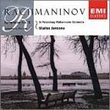
![Franz Lehar: The Land of Smiles / Gustafson, Hadley, Itami, Atkinson; Bonynge [in English]](https://nationalbookswap.com/cd//m/22/6122/6006122.jpg)

